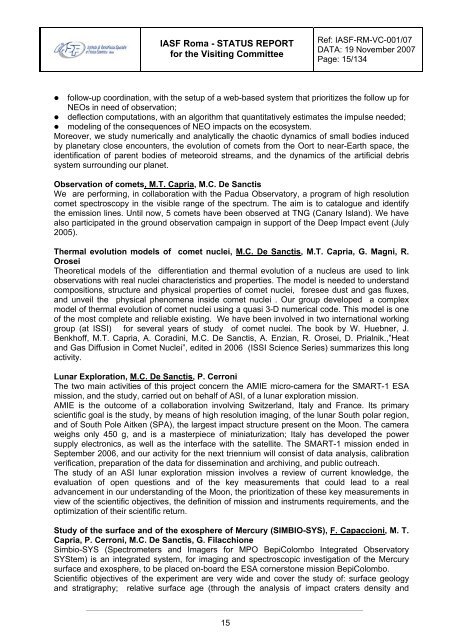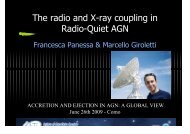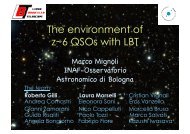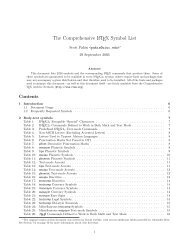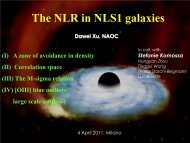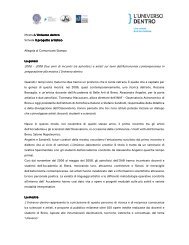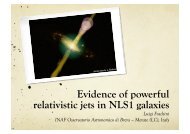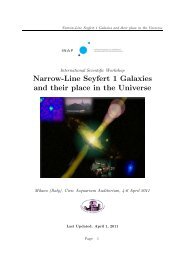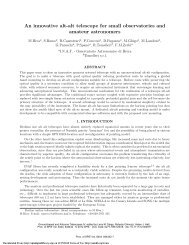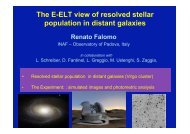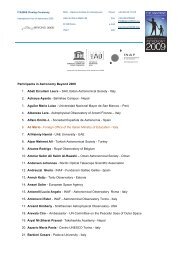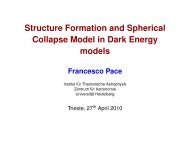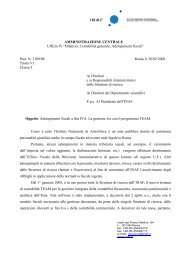IASFRome_StatusReport - INAF-IASF-Roma
IASFRome_StatusReport - INAF-IASF-Roma
IASFRome_StatusReport - INAF-IASF-Roma
Create successful ePaper yourself
Turn your PDF publications into a flip-book with our unique Google optimized e-Paper software.
<strong>IASF</strong> <strong>Roma</strong> - STATUS REPORTfor the Visiting CommitteeRef: <strong>IASF</strong>-RM-VC-001/07DATA: 19 November 2007Page: 15/134• follow-up coordination, with the setup of a web-based system that prioritizes the follow up forNEOs in need of observation;• deflection computations, with an algorithm that quantitatively estimates the impulse needed;• modeling of the consequences of NEO impacts on the ecosystem.Moreover, we study numerically and analytically the chaotic dynamics of small bodies inducedby planetary close encounters, the evolution of comets from the Oort to near-Earth space, theidentification of parent bodies of meteoroid streams, and the dynamics of the artificial debrissystem surrounding our planet.Observation of comets, M.T. Capria, M.C. De SanctisWe are performing, in collaboration with the Padua Observatory, a program of high resolutioncomet spectroscopy in the visible range of the spectrum. The aim is to catalogue and identifythe emission lines. Until now, 5 comets have been observed at TNG (Canary Island). We havealso participated in the ground observation campaign in support of the Deep Impact event (July2005).Thermal evolution models of comet nuclei, M.C. De Sanctis, M.T. Capria, G. Magni, R.OroseiTheoretical models of the differentiation and thermal evolution of a nucleus are used to linkobservations with real nuclei characteristics and properties. The model is needed to understandcompositions, structure and physical properties of comet nuclei, foresee dust and gas fluxes,and unveil the physical phenomena inside comet nuclei . Our group developed a complexmodel of thermal evolution of comet nuclei using a quasi 3-D numerical code. This model is oneof the most complete and reliable existing. We have been involved in two international workinggroup (at ISSI) for several years of study of comet nuclei. The book by W. Huebner, J.Benkhoff, M.T. Capria, A. Coradini, M.C. De Sanctis, A. Enzian, R. Orosei, D. Prialnik.,”Heatand Gas Diffusion in Comet Nuclei”, edited in 2006 (ISSI Science Series) summarizes this longactivity.Lunar Exploration, M.C. De Sanctis, P. CerroniThe two main activities of this project concern the AMIE micro-camera for the SMART-1 ESAmission, and the study, carried out on behalf of ASI, of a lunar exploration mission.AMIE is the outcome of a collaboration involving Switzerland, Italy and France. Its primaryscientific goal is the study, by means of high resolution imaging, of the lunar South polar region,and of South Pole Aitken (SPA), the largest impact structure present on the Moon. The cameraweighs only 450 g, and is a masterpiece of miniaturization; Italy has developed the powersupply electronics, as well as the interface with the satellite. The SMART-1 mission ended inSeptember 2006, and our activity for the next triennium will consist of data analysis, calibrationverification, preparation of the data for dissemination and archiving, and public outreach.The study of an ASI lunar exploration mission involves a review of current knowledge, theevaluation of open questions and of the key measurements that could lead to a realadvancement in our understanding of the Moon, the prioritization of these key measurements inview of the scientific objectives, the definition of mission and instruments requirements, and theoptimization of their scientific return.Study of the surface and of the exosphere of Mercury (SIMBIO-SYS), F. Capaccioni, M. T.Capria, P. Cerroni, M.C. De Sanctis, G. FilacchioneSimbio-SYS (Spectrometers and Imagers for MPO BepiColombo Integrated ObservatorySYStem) is an integrated system, for imaging and spectroscopic investigation of the Mercurysurface and exosphere, to be placed on-board the ESA cornerstone mission BepiColombo.Scientific objectives of the experiment are very wide and cover the study of: surface geologyand stratigraphy; relative surface age (through the analysis of impact craters density and15


